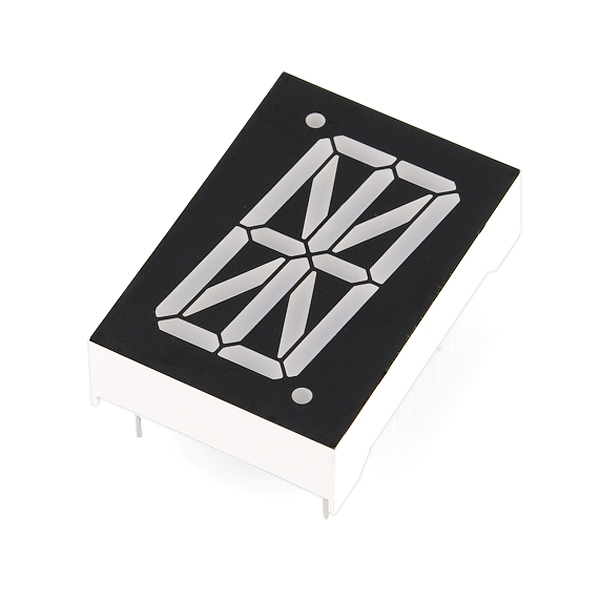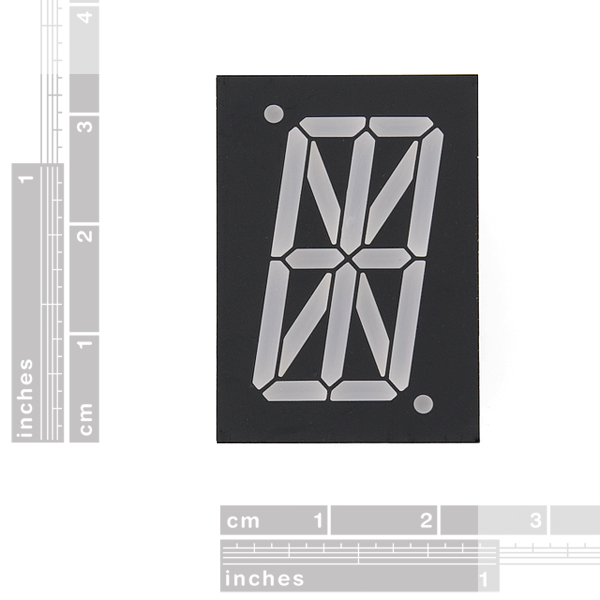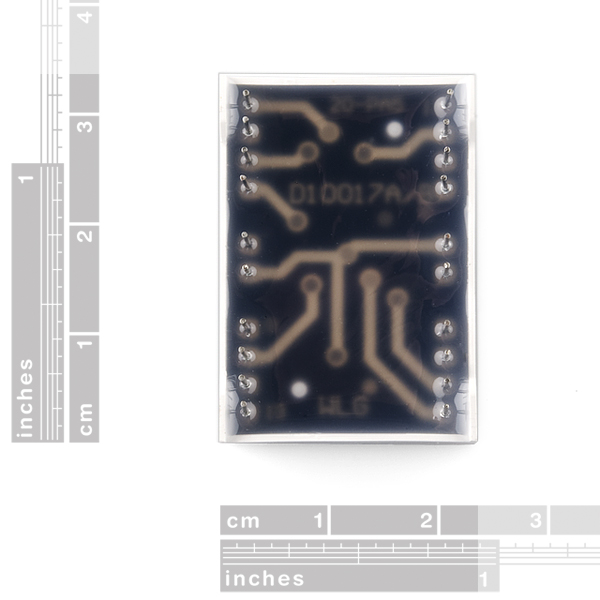×
SparkFun will be closed on Tuesday, November 5th to support our team in being able to go out and vote! Orders placed after 2 pm MT Monday, November 4th will ship on Wednesday, November 6th. Thanks for your patience and understanding.
1.0" Single Digit Alphanumeric Display - Red
Alphanumeric displays are pretty neat. Use them for numbers, use them for letters, or both. They are a good size and brightness for easy reading. The decimal points aren't connected, so keep that in mind when ordering.
We also carry these in blue and greenish yellow.
- 1" Digit Height
- Red Display
- Common Anode
- [Datasheet](http://www.sparkfun.com/datasheets/Components/LED/7-Segment/yetda red alphanumeric S-10012RSK11.pdf)
1.0" Single Digit Alphanumeric Display - Red Product Help and Resources
Core Skill: Electrical Prototyping
If it requires power, you need to know how much, what all the pins do, and how to hook it up. You may need to reference datasheets, schematics, and know the ins and outs of electronics.
Skill Level: Competent - You will be required to reference a datasheet or schematic to know how to use a component. Your knowledge of a datasheet will only require basic features like power requirements, pinouts, or communications type. Also, you may need a power supply that?s greater than 12V or more than 1A worth of current.
See all skill levels
Comments
Looking for answers to technical questions?
We welcome your comments and suggestions below. However, if you are looking for solutions to technical questions please see our Technical Assistance page.
Customer Reviews
5 out of 5
Based on 1 ratings:
Goodie
Big and bright, too bad it's common anode, but that's ok for single digit use.






Why use one of these when you could use a Burroughs B7971? Google it. There's a Yahoo group called smartsockets dedicated to them.
So other don't have to look it up:
"Burroughs B7971" are Nixie tubes. Vacuum tubes with filaments that light up to make alphanumeric characters. Not very practical nor are they easy to find to purchase.
They are freaking awesome, however.
TTL voltage compatibility, battery life, shock resistance, cost, no sputtering problems, controllable brightness, preserving night-adapted vision, lower profile, lighter weight... there are a few reasons to use this product instead of the tube.
From the description:
"The decimal digits aren't connected, so keep that in mind when ordering."
i don't understand this statement. Can anyone explain in more detail?
We don't need a breakout board, but a serial backpack would be sweet. There is a general lack of s/w out there (avr native or arduino, etc.) to control these types of displays.
It's sad the decimal points aren't connected... lame... perhaps SFE can find another cheap Chinese supplier to source some WITH the DP's. Thx!
The decimal places are just for show. There are no LEDs under them. Does that make sense?
You don't really need much software really to control them. They are just a series of LEDs. Just make a small program that turns on the appropriate LEDs for each letter or character. Not too hard, but a library would be nice.
The confusion comes from using "decimal digits" rather than "decimal points". It should read: <br />
<br />
"The two corner decimal points are not connected."
Looking at the front and back it appears that light could shine through the decimal spots. Could an led be installed behind the display to light up a decimal should one be required? Also these things appear to be made out of plastic I wonder if you could drill out a small hole and install an led behind the decimal. Any recommendations for handling that if you want a '.' or a ':' in your display?
This can work without the separate driver module, right? I'm planning on using this with a compass and either Arduino Pro Mini or Pro Micro. I will be getting power to it through the Arduino from a car charger. Also, do all of the colors use the same amount of power?
The datasheet document link is broken.
Seems fine here - though the servers were having issues for a while (problems at the DC), so you may tried to access when that was going on :)
Do these come with pins attached, or do you have to add header pins?
(Male) pins are permanently* attached to the body , same as e.g. a resistor, transistor or IC. (*experience with most 7segs tells me they break off pretty easily and fixing that is a pain, so treat them gently)
Just picked up 10 of these in red and 10 in green for a clock, they work great! I have a 40 pin PIC driving each set of 10 over a serial interface from an Arduino, they are bright and easily multiplexed. Good times.
Not available for backorder! Whats up?
Be aware that the larger segments on these have 2 LEDs while the smaller ones only have one. It doesn't make a visual difference, but it's something to be aware of when designing your circuit.
The problem in the picture is studio flash which lits almost everything in the picture, so the difference between leds and flash illuminated areas is less obvious than in ordinary indoor lighting.
alphanumeric serial display breakout comming soon maybe?
"Note: We are working on a breakout board and will have it available shortly after you actually needed it."
I don't think a breakout board is necessary with these. The pin spacing is 0.1" so they are already breadboard friendly and can be used with normal perf board.
Although I'd say the same thing about the four digit seven segment displays and SFE did make board for those (but not really a breakout board, more of a serial interface board).
Maybe, I'm not sure what's in the works, but we might be coming out with something, no promises. I will post it if we do plan on coming out with something.
These look pretty aweseome, but the demonstration picture makes it look like they're more reflective than transmissive! Are the unlit segments really about as radiant as the lit ones?
They are difficult to photograph. It looks like any other alphanumeric. They are quite bright and look like LED bar graphs, or 7 segments.
I was guesing they were being driven at a low level in that picture, or maybe some HDR was applied. I'd rather see the segments in a dark room and wash out the rest of the picture, but I digress. Awesome product.
You just might get your wish.
It's not mentioned in the datasheet which pins are for the two dot-points?!
The dots aren't connected to anything, so there's no pin out for them.